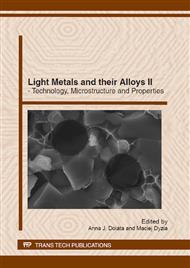p.75
p.81
p.89
p.101
p.109
p.115
p.123
p.131
p.137
Effect of Modification on the Structure and Properties of QE22 and RZ5 Magnesium Alloys
Abstract:
Magnesium alloys are the lightest, widely used structural material. They are often used in aeronautical and automotive industries, where the weight savings are essential. Magnesium alloys present acceptable mechanical properties but their high temperature properties are unsatisfactory. This led to development of magnesium alloys with rare earth elements addition. To achieve good mechanical properties these alloys are modified with zirconium. Modification affects positively also corrosion resistance of Mg-RE alloys. It is important to study impact of modifier amount on the structure and properties of these alloys. Unmodified and modified alloys were investigated. Three variants of modification were: modification according to Magnesium-Elektron specification, 50% and 100% more modifier. Mechanical and structural properties were investigated. Fractures were observed on scanning electron microscope. Results showed that grain refinement and yield strength increase with increasing amount of modifier. Impact of modification on tensile strength is unclear, probably because of non-metallic inclusions in the material’s structure. The inclusions sources are oxygenated nappe of liquid metal and fluxes, used during smelting.
Info:
Periodical:
Pages:
109-114
Citation:
Online since:
August 2012
Authors:
Price:
Сopyright:
© 2012 Trans Tech Publications Ltd. All Rights Reserved
Share:
Citation:


